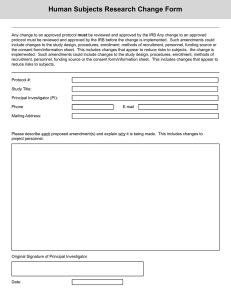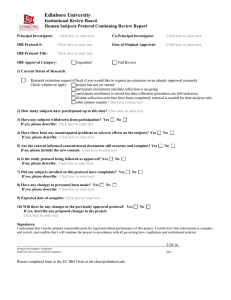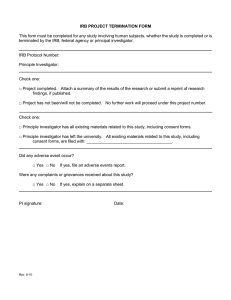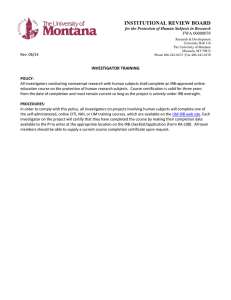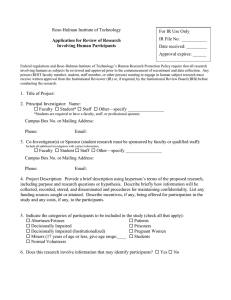P5 Submission of New Protocol for Review by the IRB (DOC)
advertisement
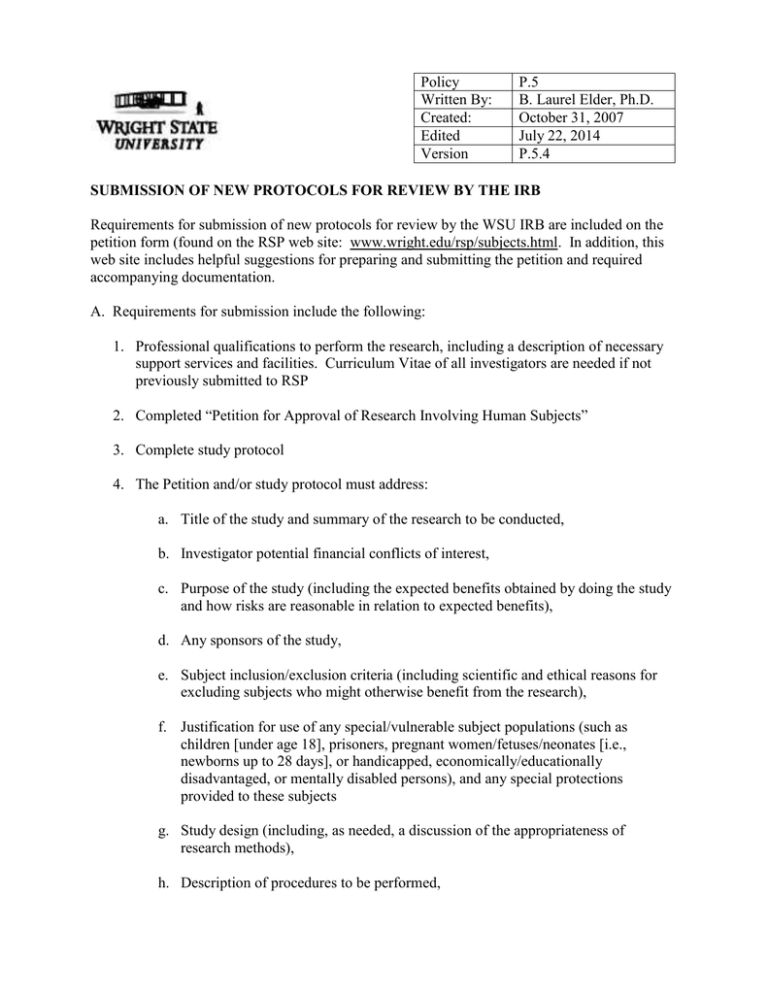
Policy Written By: Created: Edited Version P.5 B. Laurel Elder, Ph.D. October 31, 2007 July 22, 2014 P.5.4 SUBMISSION OF NEW PROTOCOLS FOR REVIEW BY THE IRB Requirements for submission of new protocols for review by the WSU IRB are included on the petition form (found on the RSP web site: www.wright.edu/rsp/subjects.html. In addition, this web site includes helpful suggestions for preparing and submitting the petition and required accompanying documentation. A. Requirements for submission include the following: 1. Professional qualifications to perform the research, including a description of necessary support services and facilities. Curriculum Vitae of all investigators are needed if not previously submitted to RSP 2. Completed “Petition for Approval of Research Involving Human Subjects” 3. Complete study protocol 4. The Petition and/or study protocol must address: a. Title of the study and summary of the research to be conducted, b. Investigator potential financial conflicts of interest, c. Purpose of the study (including the expected benefits obtained by doing the study and how risks are reasonable in relation to expected benefits), d. Any sponsors of the study, e. Subject inclusion/exclusion criteria (including scientific and ethical reasons for excluding subjects who might otherwise benefit from the research), f. Justification for use of any special/vulnerable subject populations (such as children [under age 18], prisoners, pregnant women/fetuses/neonates [i.e., newborns up to 28 days], or handicapped, economically/educationally disadvantaged, or mentally disabled persons), and any special protections provided to these subjects g. Study design (including, as needed, a discussion of the appropriateness of research methods), h. Description of procedures to be performed, Note: the procedures must include information on differentiation of usual care from research (if appropriate). i. This applies when the investigator provides for usual care. If the protocol involves “usual care,” the protocol must either include a narrative section or there must be a separate document in the IRB application that clearly differentiates the research intervention(s) from “usual care” (whether the “usual care” is limited to one “arm” of the study or is being delivered to all study subjects). ii. When a study involves “usual care,” in the protocol or a separate document in the IRB application the investigator must clearly designate the individual or entity (e.g., the appropriate research personnel versus the subject’s health care provider) responsible for relevant aspects of both the research and the usual care. iii. The subject needs to be able to identify which activity (e.g., treatment or service) is research, and which is usual care, and know who (the researcher or the subject’s health care provider) is responsible for: 1. Explaining potential risks and be benefits of the treatment or service to the subject; 2. Providing the treatment or service; 3. Monitoring the treatment or service, as applicable; 4. Defining whether the adverse events result from usual care or research, as applicable; 5. Alerting the subject if there is a problem with the treatment or service (e.g., a newly discovered risk, a product recall); and 6. Documenting the subject’s clinical course while receiving the treatment or service, as applicable. i. Risk assessment and safety monitoring provisions For prospective studies involving more than minimal risk, this plan must include, but is not limited to, the following: 1. What safety information will be collected, including SAEs (for VA studies, see VHA Handbook 1058.01); 2. How the safety information will be collected (e.g., with case report forms, at study visits, by telephone calls with subjects); 3. The frequency of data collection including when safety data collection starts; 4. The frequency or periodicity of review of cumulative safety data; 5. If not using a DMC, and if applicable, statistical tests for analyzing the safety data to determine if harm is occurring; 6. Provisions for the oversight of safety data (e.g., by a DMC); and 7. Conditions that trigger an immediate suspension of the research, if applicable. j. Circumstances surrounding consent procedure, including setting, subject autonomy concerns, language difficulties, vulnerable populations, k. Procedures for documentation of informed consent, including any procedures for obtaining assent from minors (‘minor’ is defined in Ohio as an individual under the age of 18), use legally authorized representatives, witnesses, translators and document storage, l. Any remuneration to subjects for their participation (see http://www.wright.edu/rsp/IRB/remuneration_guide.html), m. Any compensation for injured research subjects, n. Provisions for protection of subject’s privacy and data confidentiality, Provisions for Reuse of Data. This means the investigator, if the data may be reused in other studies , describes the research data repository in which the data is to be stored (for VA studies, see VHA Handbook 1200.12). There must be a research informed consent and a HIPAA authorization associated with the protocol unless these requirements are waived by the IRB. If the IRB does not waive the requirements then the informed consent and HIPAA authorization content must include language on the uses and disclosures of the data as defined in the protocol as well as information on how privacy and confidentiality will be maintained and how the data will be secured. If the creation and operation of the data repository is not included in the data collection protocol, there must be a separate IRB-approved protocol for the creation and operation of the data repository (for VA studies, see VHA Handbook 1200.12). Provisions for Future Use of Specimens. If specimens are to be retained after the end of the study for future research, information must be included on where the specimens will be retained, who will have access to them, and how long they will be retained. Current applicable institutional, VA (for VA studies) and other Federal requirements must be met for handling, use and storage of biologic specimens and data (see VHA Handbook 1200.12 for VA studies) o. Extra costs to subjects for their participation in the study, p. Inclusion/exclusion of women, minorities, and/or children. q. Professional qualifications to do the research (including a description of necessary support services and facilities); 5. Investigator’s Brochure (when one exists); 6. The case report form (when one exists); 7. The proposed informed consent document, including translated consent documents, as necessary, considering likely subject population(s); or request for waiver of the requirement to obtain informed consent; 8. Copies of advertisements (see http://www.wright.edu/rsp/IRB/advert_guide.html) and surveys, questionnaires, or other materials provided to subjects; 9. Copies of relevant grant applications (if any); 10. Documentation verifying IND or IDE numbers or status (if appropriate) Exemption 1. That the research involves: The drug product is lawfully marketed in the United States. The investigation is not intended to be reported to FDA as a well- controlled study in support of a new indication for use nor intended to be used to support any other significant change in the labeling for the drug. If the drug that is undergoing investigation is lawfully marketed as a prescription drug product, the investigation is not intended to support a significant change in the advertising for the product. The investigation does not involve a route of administration or dosage level or use in a patient population or other factor that significantly increases the risks (or decreases the acceptability of the risks) associated with the use of the drug product. The investigation is conducted in compliance with 21 CFR 50 and 56. The investigation is conducted in compliance with the requirements of 21 CFR 312.7. Exemption 2. That the research is: A clinical investigation of an in vitro diagnostic biological product that involves one or more of the following: • Blood grouping serum. • Reagent red blood cells. • Anti-human globulin. The diagnostic test is intended to be used in a diagnostic procedure that confirms the diagnosis made by another, medically established, diagnostic product or procedure. The diagnostic test is shipped in compliance with 21 CFR 3 12.160. Exemption 3. That the research is: A clinical investigation involving use of a placebo if the investigation does not otherwise require submission of an IND. For device submissions in which no IDE number is provided, in formation must be provided allowing the IRB coordinator or IRB staff to confirm that the devise is one that satisfies one of the following device exemptions: A device, other than a transitional device, in commercial distribution immediately before May 28, 1976, when used or investigated in accordance with the indications in labeling in effect at that time. A device, other than a transitional device, introduced into commercial distribution on or after May 28, 1976, that FDA has determined to be substantially equivalent to a device in commercial distribution immediately before May 28, 1976, and that is used or investigated in accordance with the indications in the labeling FDA reviewed under Subpart E of part 807 in determining substantial equivalence. A diagnostic device, if the sponsor complies with applicable requirements in 21 CFR 809.10(c) and if the testing: • Is noninvasive. • Does not require an invasive sampling procedure that presents significant risk. • Does not by design or intention in introduce energy into a participant •Is not used as a diagnostic procedure without confirmation of the diagnosis by another, medically established diagnostic product or procedure. A device undergoing consumer preference testing, testing of a modification, or testing of a combination of two or more devices in commercial distribution, if the testing is not for the purpose of determining safety or effectiveness and does not put participants at risk. A custom device as defined in 21 CFR 8 12.3(b), unless the device is being used to determine safety or effectiveness for commercial distribution. 11. For funded studies in which the sponsor (including DHHS/NIH) has approved the human subjects protocol and consent form, submit a copy of these documents B. Number of copies of documents to be submitted For protocols involving more than minimal risk (review by the full Institutional Review Board): Submit 26 copies of the completed petition and supporting documents (one copy must contain original signatures of principal investigator, co-investigator(s) and, for a student PI, the faculty advisor). In addition, submit 4 copies of the complete research protocol, 2 copies of the grant proposal (if applicable) and 4 copies of the investigator’s brochure (if applicable). If this is a funded study and the sponsor (incl. DHHS/NIH) has approved the human subjects protocol and consent form, submit one copy of these documents as approved. For protocols involving no more than minimal risk (expedited review by the screening committee): Submit 4 copies of the completed petition and supporting documents (one copy must contain original signatures of principal investigator, co-investigator(s) and, for a student PI, the faculty advisor). In addition, submit 1 copy of the research protocol, if available For protocols meeting criteria for exempt research: Submit 1 copy of the completed signed petition and supporting documents C. The submission may be signed electronically or manually. The IRB will accept the following as documentation from an investigator: 1. An original, signed signature 2. A pdf file, or photo file of a signature 3. An indication that the signature is electronic (e.g. //es//Name) to indicate that this is Jane’s electronic signature 4. A statement that the signature belongs to the investigator (e.g. “I attest that this is my electronic signature”) The electronic signature needs to be submitted on the e-mail account of the principal investigator (or study coordinator when this person is responsible for the study submissions). If the PI wishes to submit the electronic signatures for coinvestigators, this can be done by sending a file as described above from the co-PI under the e-mail of the Principal Investigator or Study Coordinator (to indicate that this person has approved the coinvestigator’s attestation). D. Protocols must be received by RSP at least eight working days in advance of the meeting at which they will be reviewed.
